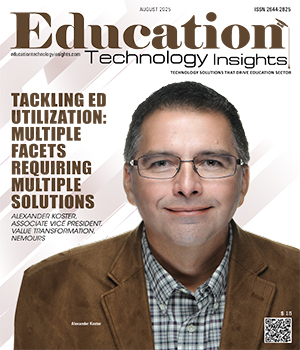THANK YOU FOR SUBSCRIBING
Be first to read the latest tech news, Industry Leader's Insights, and CIO interviews of medium and large enterprises exclusively from Education Technology Insights
Message Sent ≠ Message Received: Why Leaders Must Think Like Designers
Tamara Rose, Director of Professional Learning and Development, River Springs Charter School
 Tamara Rose, Director of Professional Learning and Development, River Springs Charter School
Tamara Rose, Director of Professional Learning and Development, River Springs Charter SchoolTamara Rose serves as Director of Professional Growth & Development at Springs Charter Schools in Southern California. With over 20 years of experience in education, she leads new teacher onboarding, coaching, professional development and personalized learning programs. A futurist and doctoral student in organizational leadership, she focuses her research on generational theory and transformational leadership. She is committed to building educator capacity through meaningful, human-centered professional learning.
Have you ever felt frustrated because no one seems to listen anymore? You press send on an email, share updates in a meeting, or post information on a platform and still, nothing changes. You think, “I already said that,” or “Why won’t they just read their email?” What you’re facing isn’t a compliance issue. It’s a communication issue. In a world where people are overwhelmed and mentally saturated, it’s no longer enough to send information. We must design it so it can actually be received.
People are not ignoring us on purpose. They’re just full— emotionally, mentally and digitally. The cultural climate is loud and chaotic. Every day, we navigate constant notifications, policy updates, social media noise, political tension and fearbased messaging. Burnout is no longer an exception—it is the backdrop of modern life. In this environment, being an information manager, someone who simply distributes content, is not enough. Leaders today must become information designers.
I learned this while onboarding a new curriculum specialist to my team. We were preparing for a professional learning event and needed a short, two-minute welcome slide. Forty-five minutes later, we were still working on it. She was stunned. We were already stretched thin with projects, deadlines and events; why spend this much time on something so small?
I understood her frustration. But I also knew this: it does not matter what we say; it matters if it lands.
She saw a slide. I saw an opportunity to build trust, clarity and connection. Before I put words on a slide, I ask: Who is in the room? What do they value? What are they worried about? Do they have the emotional or cognitive capacity to process this right now? What format will actually reach them: story, graphic, data, humor or conversation? Because if it doesn’t land, it doesn’t lead.
That is the difference between a communicator and a designer. Communicators ask, “Did I deliver the information?” Designers ask, “Will they hear it, feel it and remember it?” Success is no longer measured by, “Was it sent?” but by, “Did it make a difference?”
And it gets even more complex when you consider generational differences. Baby Boomers and Generation X often value full context, detailed explanations and formal communication. Millennials look for purpose, relevance and efficiency. Gen Z processes information visually and quickly and expects authenticity above all. The same message, delivered the same way, will not land the same across generations. If we ignore this, we’re not just miscommunicating; we’re missing our audience entirely.
When communication isn’t designed with intention, it leads to confusion, resistance, rework and frustration. People don’t follow through, not because they don’t care, but because the message never made it through the noise. Initiatives fail not because they’re bad ideas, but because they were delivered in ways people couldn’t receive.
Thoughtful communication is not extra work. It is leadership. It is how trust is built, how change takes root and how vision becomes reality. Clarity is kindness. Impact happens when messages land.
So, the question is no longer, “Did I tell them?” The real question is: “Did I design this to be received?”
Read Also
Preparing Students for More than their First Job
Purpose, People and Progress: A CIO's Vision for Higher Education
Why Teachers Must be Curriculum Creators
You Can't Learn to Swim at the Library
Leadership as the Mechanism for Advancing Data Governance in Higher Education
Rewiring Stem Education for the Future

I agree We use cookies on this website to enhance your user experience. By clicking any link on this page you are giving your consent for us to set cookies. More info

However, if you would like to share the information in this article, you may use the link below:
www.educationtechnologyinsightsapac.com/cxoinsights/tamara-rose-nid-3515.html





















